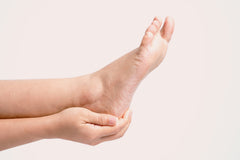Understanding Morton’s Neuroma

by Dr. Emily Splichal, DPM MS
Few things present itself like that of a Morton’s Neuroma. From the sharp pain at push-off to the numbness in the 3rd and 4th digits, this benign nerve mass can be one of the most frustrating conditions presented to the Podiatrist office.
Once you have the diagnosis, treatment options may vary and ultimately surgery may be recommended. This article will describe what a neuroma is, common causes and the most effective treatment options.
What is a Neuroma?
A neuroma is a benign mass of nerve tissue that results from a thickening of the tissue that surrounds the digital nerves that lead to the toes. Often associated with mechanical pressure or compression of the forefoot, this repeated irritation leads to inflammation and scarring of the nerve bundle.
If you’ve ever heard of a Morton’s neuroma, this is a nerve irritation specifically occurring between the 3rd and 4th digits. Neuromas can occur in between all digits of the feet and even into the digits of the hands.

What are the Symptoms?
The most classic symptoms of a neuroma include sharp pain in the ball of the foot when pushing off or taking a step, the sensation of walking on a pebble or a wrinkle in the sock, and numbness or tingling into the digits.
Not all neuromas are symptomatic or present with the same level of symptoms. Many patients have neuromas and don’t even realize it until they have an MRI of their foot for another unrelated foot injury
How are They Diagnosed?
If you go to see a Podiatrist a neuroma can most often be diagnosed “clinically” which means based on description and a few simple clinical tests. The most common test for diagnosing a neuroma is referred to as a “Mulder’s click”. By squeezing the forefoot you can put pressure on the neuroma and feel it shift between the metatarsal heads, creating a palpable snap or click.
Although x-rays are often performed, the most important radiological examination for diagnosing a neuroma is either an ultrasound or MRI.
What are the Treatments?
Most initial treatment options are to minimize pressure to the forefoot and reduce inflammation around the neuroma.
Some of our favorite recommendations to reduce pressure to the forefoot include:
- Footwear with wide toe box such as that found in minimal shoes
- Toe spacers to gently stretch the tissue around the digits
- Metatarsal pads to spread the metatarsal heads
- Releasing the foot muscles with a foot roller
And then, some of our favorite ways to reduce inflammation include:
- Steroid injections can be extremely effective in an acute setting
- Topical or oral NSAIDs
- Red light or laser therapy
- Systemic enzymes such as serrapeptidase



Leave a comment